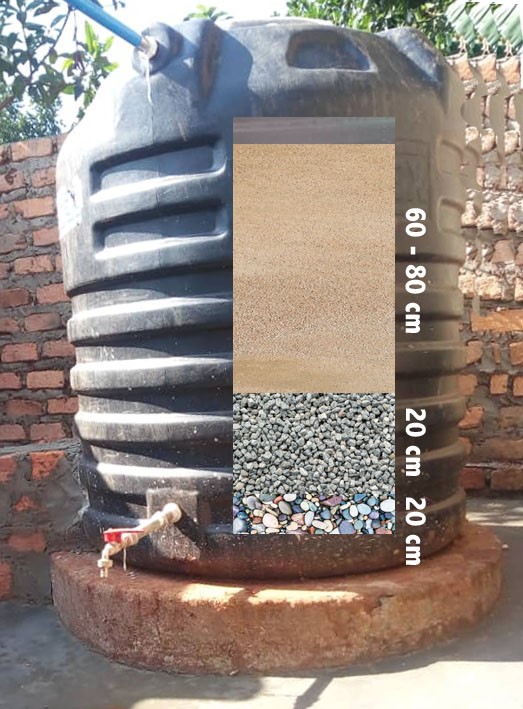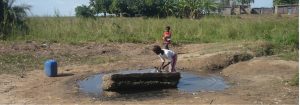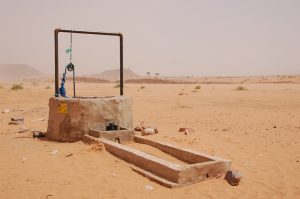1.- Brief description
In many parts of rural Africa and indeed in many parts of the world, water is supplied by a pond, a low area in the ground primarily stormwater-fed, either through runoff or an unconfined aquifer. Most of these mud holes are unprotected, often used for watering livestock, with high turbidity and high bacteria count.
In accordance with WHO Guidelines “Small water supplies where resources are very limited and where there is limited or no treatment may not be able to achieve such low levels of turbidity. In these cases, the aim should be to produce water that has turbidity of at least less than 5 NTU (Nephelometric Turbidity Units) and, if at all possible, below 1 NTU.”1
Turbidity levels in these water sources, in the experience of the author in the Mityana district of Uganda, range from 40+ NTU to several 100 NTUs. Whether chlorination, ozone, boiling or other disinfection method, high levels of turbidity inhibit the effectiveness of disinfection.
Resources in most such communities are limited and complex technologies difficult to implement in a mostly uneducated populace. Rapid sand filtration provides a simple technology to reduce turbidity, suited to the resources and education level of such villages.
2.- Background
Sand filtration has been used to purify water since the 15th century in ancient Egypt. It is simple, easy to operate, adaptable to local materials and cost effective. In rural Uganda, for example, a sand filter costs about 1/10th the cost of drilling a well. Sand filtration through a medium of sand pore size 0,3 to 0,8 mm has proven effective in reducing turbidity to manageable levels. In addition, a sand filter has an inherent security feature – by virtue of its weight, it’s hard to steal.
Consideration should be given to size – a garbage can – sized sand filter is usually sufficient for a family, while a 1000 liter water tank would be sufficient to serve about 100 persons. A stable, level base is required. Concrete is usually available in the local area. Because of the weight of sand, bracing is typically not necessary, but leveling is essential.
3.- Height, Cross-sectional Area, and Sand Distribution (short circuiting).
There are several essential design factors. The height of the filter sand layer (0,3 – 0,8 mm grain size) should be a minimum of 60 cm for effective filtration, although 80 cm is preferred. The actual filtration takes place primarily in the upper 20 cm of sand, decreasing exponentially through the sand column. Beneath the filter sand, a layer of coarse gravel of 20 cm or more is recommended. The gravel layer prevents the filter sand layer from washing out. Lastly, a layer of golf ball sized pebbles around the outlet pipe is recommended to ensure a free-flowing outlet.
A minimum diameter of 60 cm is recommended to enhance the longevity of filtration prior to the need for backwash. As dirt and debris filter through the sand, a layer of debris builds up on the top of the sand. Consequently the larger the surface area, the more area the debris has to distribute over. The debris layer will, over time, constrict the upper level of sand, resulting in a reduction in outflow of water through the filter. The phenomenon has its advantages. When the operator notices a greatly reduced output of water flow, it’s time for washing the filter sand.
Another practical consideration is the height of the filter. Water in rural areas is typically gathered by women and children. In rural areas of Uganda, water is typically gathered in 20-liter water cans. The weight of the water cans is considerable. The water-bearers should be capable of lifting the water cans and pouring them into the filter. This limits the practical height of the filter to 1,2 to 1,4 m, without requiring a ladder.
The opening of the filter should be large enough to allow removal of the sand for washing.
Initial Sand Preparation:
Even washed sand typically still contains some fine particles. It is recommended to wash the sand prior to filling the filter. Since disinfection is not the primary goal, any clear water source can be used to wash the sand. Even after washing, it can take several days to weeks to achieve maximum turbidity reduction as the fine particles around the sand wash out.
Stratification versus Sand Distribution: In filling the sand filter with sand, it is recommended to first add a layer of water to the filter and then add the sand to it. Filling the tank in this fashion does increase the risk of stratification, as the larger sand grains will settle to the bottom first, followed by the finer sand. In practice, however, this has not proved to be a problem. Since the sand is very heavy, it must, of necessity, be filled in multiple loads. Each load then stratifies, creating numerous small layers of coarser-grained sand followed by finer-grained followed again by the next layer of coarser/finer sand.
Far worst is the problem of creating short-circuits in the sand filter. Without the layer of water, the filling of sand can create air pockets of larger size, as the sand is layered. The presence of air pockets is easily observed when, after filling the sand without water, water is added for the first time. This is typically accompanied by several large bubbles breaking the surface of the water as the air pockets collapse. In practice, however, adding water does not typically collapse all of the air pockets, especially those found in the deeper levels.
The presence of these pockets can result in the water to be filtered taking the path of least resistance and bypassing the filter sand in favor of the air pockets, resulting in insufficient filtering.
Adding a layer of water prior to filtering allows the sand to be evenly distributed without air bubbles in the filter. Gentle stirring during filling can help ensure that the corners fill to the same level as the center, and release any latent air bubbles.

4.- Cleaning and Maintenance
A rule of thumb, based on the Uganda experience and depending on the turbidity of the source, and the surface area of the sand filter, cleaning the upper sand level may be needed as early as 3 months for the 1000 liter tank. Larger surface areas may only require cleaning the sand annually. If the rate of filtration substantially slows, cleaning or backwashing the sand is needed.
In preparation for cleaning the sand, it is recommended to filter 100 liters of water as cleaning water, then emptying the filter of water. Clean the sand by removing the top 20-30 cm of sand and hand washing (typically done in large wash pans). The first stages of rinsing can be performed with raw water. The final washing should use the filtered water. Typically 4-5 wash stages are needed.
After washing, refill the filter with water and re-add the sand. There may be an initial flushing period when the filter is put back into use.
5.- Results
In practice, the filter described above as achieved very good results. The filter has been installed in several villages in the Mityana District of Uganda. The filter installed at Kyamagemule, for example, achieved a filling rate of about 3 minutes per 20 L water canister. After the initial flushing period, the turbidity was consistently below 10 NTUs. Cleaning the sand was only required after 1 year. The filter has been in continuous operation for 4 years.
Salt chlorination at 2 mg/l was used for disinfection.
References
WHO. Guidelines for Drinking-water Quality, Fourth Edition. Chapter 10. Acceptability aspects: Taste, odour and appearance [Accesible 05.11.2021, CrossRef]


